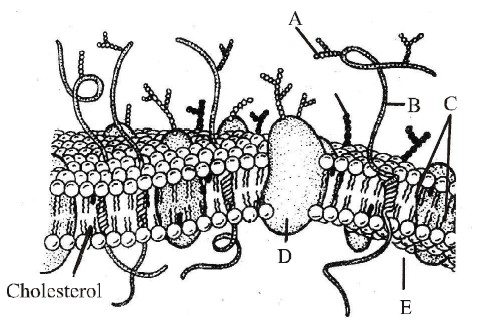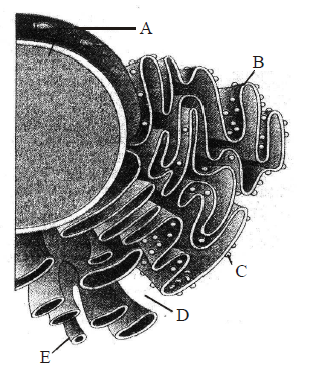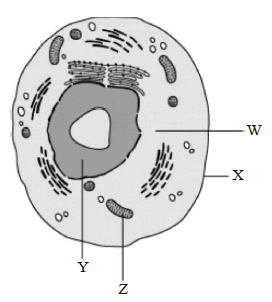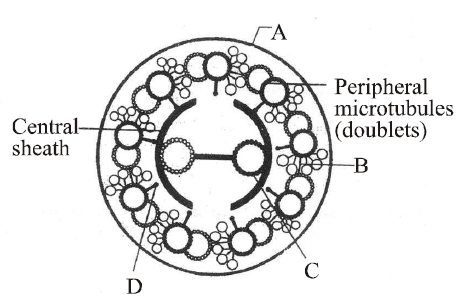Which of the following cell organelles were discovered after the introduction of electron microscope?
Mitochondria
Endoplasmic reticulum
Ribosomes
Both (b) and (c)
Correct Answer :
D. Both (b) and (c)
Endoplasmic reticulum and ribosomes are the cell organelles which were discovered after the introduction of electron microscope.
Related Questions
The diagram given below represent a filuid mosaic model of plasma membrance. Match the components marked as A, B, C, D and E in the diagram below from the list (i) to (vii).

- Sugar
- Protein
- Lipid bilayer
- Integral protein
- Cytoplasm
- Cell wall
- External protein
A - (i), B - (ii), C - (iii), D - (iv), E - (v)
A - (ii), B - (i), C - (iii), D - (iv), E - (v)
A - (i), B - (ii), C - (iii), D - (iv), E - (vi)
A - (i), B - (ii), C - (iii), D - (vii), E - (v)
The best material for study of structure of cell membrane is
RBC of human
RBC of frog
cheek cell of human
liver cell of rat
Which of the following statements is/are correct ?
- The shape of the cells may vary with the function they perform.
- Human RBC is about 7.0 ??m in diameter.
- Cytoplasm is the main area of cellular activities.
- Various chemical reactions occur in cytoplasm to keep the cell in the living state.
(i), (ii), (iii) and (iv)
Only (i) and (ii)
Only (iv)
None of the above
Which one of the following is not considered as part of the endomembrane system?
Golgi complex
Peroxisome
Vacuole
Lysosome
Identify the components labelled as A, B, C, D and E in the diagram given below from the list (i) to (viii).

- Cristae of mitochondria
- Inner membrane of mitochondria
- Cytoplasm
- Smooth endoplasmic reticulum
- Rough endoplasmic reticulum
- Mitochondrial matrix
- Ribosome
- Nucleus
A - (viii), B - (v), C - (vii), D - (iii), E - (iv)
A - (i), B - (iv), C - (vii), D - (vi), E - (iii)
A - (vi), B - (v), C - (iv), D - (vii), E - (i)
A - (v), B - (i), C - (iii), D - (ii), E - (iv)
Basal bodies are associated with the formation of
phragmoplast
cilia and flagella
cell plate
kinetochore
Function of contractile vacuole in Amoeba is
excretion and osmoregulation.
digestion and respiration.
osmoregulation and transportation.
none of the above.
Centrioles and centrosomes occur in the cells of
green plants
animals
bacteria and cyanobacteria
both (b) and (c)

Which function is carried out by the cell organelle 'X'?
helps control the movement of substance in and out of the cell
passes information from the parent cell to newly formed cell
maintains the proper shape of the cell and serves as a protective barrier
helps the cell to make food with the help of chlorophyll and sunlight
Which of the following pair are correctly matched ?
(I) Amyloplasts Store proteins
(II) Mitochondrion Power house of the cell
(III) Stroma Chlorophyll pigment
(IV) Axoneme 9 + 2 array
(I) and (III) only
(II), (III) and (IV) only
(III) and (IV) only
(II) and (IV) only
9.A student was given cell samples (A and B) to identify parts which are highlighted. He observed the samples under the microscope and list down the function of the part of cell sample. The information collected by the student is listed in the table below, on the basis of which the student infers that the samples contain the organelles.
| Sample A | Sample B |
|---|---|
| Make energy available for cellular metabolism | Generates ATP and synthes izes s ugar |
| Absent in cell that carry oxygen throughout the body | Present in plant cell |
| Called the energy currency of cell | Source o f all the food energy |
Explain why the samples were belonged to eukaryotic cell and not prokaryotic cell? Because,
eukaryotic cell have membrane bound organelles.
eukaryotic cell have non - membrane bound organelles.
eukaryotic cell are smaller and multiply more rapidly than prokaryotic cells.
eukaryotic cell are larger and multiply more rapidly than prokaryotic cells.
Which of the following is absent in prokaryotes?
DNA
RNA
Plasma membrane
Mitochondria
In which of the following the cells are held together by a Ca-pectate layer?
Primary cell wall
Secondary cell wall
Middle lamella
Tertiary cell wall
Given below are some characters of a cell organelle identify the correct organelle which shows all the characters described above.
- It is a membrane bound space found in the cytoplasm.
- It is bound by a single membrane called tonoplast.
- It contains water, sap, excretory products and other materials not useful to the cell.
- It has higher concentration of sap than the cytoplasm.
Golgi apparatus
Lysosomes
Endoplasmic reticulum
Vacuoles
Protein synthesis in an animal cell occurs
on ribosomes present in cytoplasm as well as in mitochondria.
on ribosomes present in the nucleolus as well as in cytoplasm.
only on ribosomes attached to the nuclears envelope and endoplasmic reticulum.
only on the ribosomes present in cytosol.
Which one of the following structures between two adjacent cells is an effective transport pathway?
Plasmodesmata
Plastoquinones
Endoplasmic reticulum
Plasmalemma
What would happen if lysosomes get ruptured in a cell?
Cell dies
Cell shrinks
Cell swell up
Nothing would happen
A component of cytoskeleton is
microtubule
bone
chitin
cartilage.
The given figures show two types of cell. Which structures are common to both the cells?

Nucleus and cell wall
Nucleus and cytoplasm
Ribosomes and flagella
Ribosomes and cell wall
Which of these is wrongly matched?
Chloroplasts Chlorophyll
Elaioplasts Starch
Chromoplasts Carotenoids
Amyloplasts Carbohydrates
Select the correct match of the types of neuron present in column I with its location given in column II.
| Column I | Column II |
|---|---|
| A. Centrioles | (i) Non-membrane bound organelle which helps in cell division |
| B. Fimbriae | (ii) Special structure of bacteria which help them to attach with rocks in stream and also to host tissue |
| C. Endomembrane | (iii) Includes those organelles system whose functions are coordinated |
| D. Mitochondria | (iv) Divide by fission and site of aerobic respiration |
A - (i), B - (ii), C - (iii), D - (iv)
A - (iii), B - (i), C - (ii), D - (iv)
A - (iii), B - (i), C - (iv), D - (ii)
A - (i), B - (iv), C - (iii), D - (ii)
Match column-I (cell organelle) with column-II membrane and select the correct option from the codes given below.
| Column-I | Column-II |
|---|---|
| A. Mitochondria | I. Without membrane |
| B. Lysosomes | II. Single membrane |
| C. Ribosomes | III. Double membrane |
A - I, B - II, C - III
A - III, B - I, C - II
A - III, B - II, C - I
A - II, B - III, C - I
According to widely accepted fluid mosaic model cell membranes are semi-fluid, where lipids and integral proteins can diffuse randomly. In recent years, this model has been modified in several respects. In this regard, which of the following statements is incorrect?
Proteins in cell membranes can travel within the lipid bilayer.
Proteins can also undergo flip-flop movements in the lipid bilayer.
Proteins can remain confined within certain domains of the membrane.
Many proteins remain completely embedded within the lipid bilayer.
The fluidity of membranes in a plant in cold weather may be maintained by
increasing the number of phospholipids with unsaturated hydrocarbon tails.
increasing the proportion of integral proteins.
increasing concentration of cholesterol in membrane.
increasing the number of phospholipids with saturated hydrocarbon tail.
Identify the components labelled A, B, C and D in the given section of cilia/flagella showing different parts. Choose the option which shows the correct labelling of parts.

A Plasma membrane, B Interdoublet bridge, C Central microtubule, D Radial spoke
A Plasma membrane, B Arm, C Central microtubule, D Radial spoke
A Plasma membrane, B Interdoublet bridge, C Hub, D Radial spoke
A Plasma membrane, B Interdoublet bridge, C Hub, D Arm
Match column I (cell type) with column II (size) and choose the correct option.
| Column-I | Column-II |
|---|---|
| (Cell type) | (Size) |
| A. Viruses | I. 1-2 ??m |
| B. PPLO | II. 10-20 ??m |
| C. Eukaryotic cell | III. About 0.1 ??m |
| D. Bacterium | IV. 0.02 - 0.2 ??m |
A I, B II, C III, D IV
A IV, B III, C II, D I
A I, B III, C II, D IV
A IV, B II, C III, D I
Which of the following statements are correct ?
- In prokaryotic cells, a special membranous structure formed by the extension of the plasma membrane into the cell is known as polysome.
- The smooth endoplasmic reticulum is the major site for synthesis of glycoproteins.
- RuBisCO is the most abundant protein in the whole biosphere.
- Mitochondria, chloroplasts and peroxisomes are not considered as part of endomembrane system. Of the above statements
(iii) and (iv)
(i) and (ii)
(ii) and (iii)
(i) and (iv)
An organalle devoid of membrane covering is
vacuole
ribosome
peroxisome
lysosome
Active transport differs from passive transport in that active transport
requires energy.
always requires input of ATP.
moves molecules against a concentration gradient.
both (a) and (c)
The membrane of the erythrocytes has approximately ___% of proteins and ___% lipids.
42, 50
52, 40
50, 50
60, 40
